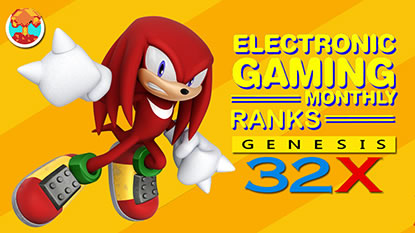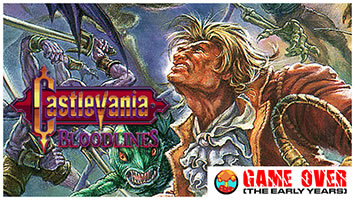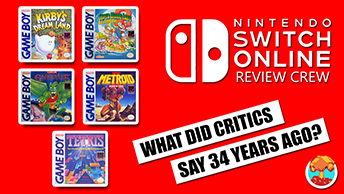- CLASSIC MAGAZINES
- REVIEW CREW
A show recapping what critics thought back
when classic games first came out! - NEXT GENERATION'S BEST & WORST
From the worst 1-star reviews to the best
5-stars can offer, this is Next Generation! - NINTENDO POWER (ARCHIVE)
Experience a variety of shows looking at the
often baffling history of Nintendo Power! - MAGAZINE RETROSPECTIVE
We're looking at the absolutely true history of
some of the most iconic game magazines ever! - SUPER PLAY'S TOP 600
The longest and most ambitious Super NES
countdown on the internet! - THEY SAID WHAT?
Debunking predictions and gossip found
in classic video game magazines! - NEXT GENERATION UNCOVERED
Cyril is back in this spin-off series, featuring the
cover critic review the art of Next Generation! - HARDCORE GAMER MAGAZING (PDF ISSUES)
Download all 36 issues of Hardcore Gamer
Magazine and relive the fun in PDF form!
- REVIEW CREW
- ELECTRONIC GAMING MONTHLY
- ELECTRONIC GAMING MONTHLY RANKS
From Mario to Sonic to Street Fighter, EGM
ranks classic game franchises and consoles! - ELECTRONIC GAMING MONTHLY BEST & WORST
Counting down EGM’s best and worst reviews
going year by year, from 1989 – 2009! - ELECTRONIC GAMING BEST & WORST AWARDS
11-part video series chronicling the ups and
downs of EGM’s Best & Worst Awards!
- ELECTRONIC GAMING MONTHLY RANKS
- GAME HISTORY
- GAME OVER: STORY BREAKDOWNS
Long-running series breaking down game
stories and analyzing their endings! - A BRIEF HISTORY OF GAMING w/ [NAME HERE]
Real history presented in a fun and pithy
format from a variety of game historians! - THE BLACK SHEEP
A series looking back at the black sheep
entries in popular game franchises! - INSTANT EXPERT
Everything you could possibly want to know
about a wide variety of gaming topics! - FREEZE FRAME
When something familiar happens in the games
industry, we're there to take a picture! - I'VE GOT YOUR NUMBER
Learn real video game history through a series
of number-themed episodes, starting at zero! - GREAT MOMENTS IN BAD ACTING
A joyous celebration of some of gaming's
absolute worst voice acting!
- GAME OVER: STORY BREAKDOWNS
- POPULAR SHOWS
- DG NEWS w/ LORNE RISELEY
Newsman Lorne Riseley hosts a regular
series looking at the hottest gaming news! - REVIEW REWIND
Cyril replays a game he reviewed 10+ years
ago to see if he got it right or wrong! - ON-RUNNING FEUDS
Defunct Games' longest-running show, with
editorials, observations and other fun oddities! - DEFUNCT GAMES QUIZ (ARCHIVE)
From online quizzes to game shows, we're
putting your video game knowledge to the test!- QUIZ: ONLINE PASS
Take a weekly quiz to see how well you know
the news and current gaming events! - QUIZ: KNOW THE GAME
One-on-one quiz show where contestants
find out if they actually know classic games! - QUIZ: THE LEADERBOARD
Can you guess the game based on the classic
review? Find out with The Leaderboard!
- QUIZ: ONLINE PASS
- DEFUNCT GAMES VS.
Cyril and the Defunct Games staff isn't afraid
to choose their favorite games and more! - CYRIL READS WORLDS OF POWER
Defunct Games recreates classic game
novelizations through the audio book format!
- DG NEWS w/ LORNE RISELEY
- COMEDY
- GAME EXPECTANCY
How long will your favorite hero live? We crunch
the numbers in this series about dying! - VIDEO GAME ADVICE
Famous game characters answer real personal
advice questions with a humorous slant! - FAKE GAMES: GUERILLA SCRAPBOOK
A long-running series about fake games and
the people who love them (covers included)! - WORST GAME EVER
A contest that attempts to create the worst
video game ever made, complete with covers! - LEVEL 1 STORIES
Literature based on the first stages of some
of your favorite classic video games! - THE COVER CRITIC
One of Defunct Games' earliest shows, Cover
Critic digs up some of the worst box art ever! - COMMERCIAL BREAK
Take a trip through some of the best and
worst video game advertisements of all time! - COMIC BOOK MODS
You've never seen comics like this before.
A curious mix of rewritten video game comics!
- GAME EXPECTANCY
- SERIES ARCHIVE
- NINTENDO SWITCH ONLINE ARCHIVE
A regularly-updated list of every Nintendo
Switch Online release, plus links to review! - PLAYSTATION PLUS CLASSIC ARCHIVE
A comprehensive list of every PlayStation
Plus classic release, including links! - RETRO-BIT PUBLISHING ARCHIVE
A regularly-updated list of every Retro-Bit
game released! - REVIEW MARATHONS w/ ADAM WALLACE
Join critic Adam Wallace as he takes us on a
classic review marathon with different themes!- DEFUNCT GAMES GOLF CLUB
Adam Wallace takes to the links to slice his way
through 72 classic golf game reviews! - 007 IN PIXELS
Adam Wallace takes on the world's greatest spy
as he reviews 15 weeks of James Bond games! - A SALUTE TO VAMPIRES
Adam Wallace is sinking his teeth into a series
covering Castlevania, BloodRayne and more! - CAPCOM'S CURSE
Adam Wallace is celebrating 13 days of Halloween
with a line-up of Capcom's scariest games! - THE FALL OF SUPERMAN
Adam Wallace is a man of steel for playing
some of the absolute worst Superman games! - THE 31 GAMES OF HALLOWEEN
Adam Wallace spends every day of October afraid
as he reviews some of the scariest games ever! - 12 WEEKS OF STAR TREK
Adam Wallace boldly goes where no critic has
gone before in this Star Trek marathon!
- DEFUNCT GAMES GOLF CLUB
- DAYS OF CHRISTMAS (ARCHIVE)
Annual holiday series with themed-episodes
that date all the way back to 2001!- 2015: 30 Ridiculous Retro Rumors
- 2014: 29 Magazines of Christmas
- 2013: 29 Questionable Power-Ups of Christmas
- 2012: 34 Theme Songs of Christmas
- 2011: 32 Game Endings of Christmas
- 2010: 31 Bonus Levels of Christmas
- 2009: 30 Genres of Christmas
- 2008: 29 Controls of Christmas
- 2007: 34 Cliches of Christmas
- 2006: 33 Consoles of Christmas
- 2005: 32 Articles of Christmas
- 2004: 31 Websites of Christmas
- 2003: 29 Issues of Christmas
- 2002: 28 Years of Christmas
- 2001: 33 Days of Christmas
- NINTENDO SWITCH ONLINE ARCHIVE
- REVIEW ARCHIVE
- FULL ARCHIVE
Is Phantom Breaker: Battle Grounds 8-Bit?
Lately it seems like the term "8-bit" has become a catch-all for anything with pixel graphics. For those of us who grew up in 1980s, we know the limitations of 8-bit technology. We understand that the Nintendo Entertainment System couldn't handle complex 3D scaling and moving polygons. Unwilling to stand for this misinformation, we've decided to fight back. It's time to ask the important question: Are You 8-Bit?
Today we're taking a look at Phantom Breaker: Battle Grounds, the action-packed 2D brawler developed by Division2 and published by Mages. Although it has been out for quite a while on Xbox Live Arcade, this retro-inspired beat-em-up was recently released on the PS Vita. To promote the game, Sony's blog decided to throw out the 8-bit term and hope for the best. Here's what they said ...
As you can see from the pictures above, Phantom Breaker offers incredible pixel graphics and an eye for detail. The backgrounds are littered with details, from colorful buildings to logos and advertising everywhere. We can not only make out our hero's eye color, but also the small details on her purple dress. Enemies speed by on bikes with elaborate helmets, but that doesn't seem to bother the man clutching a golf club. And is that a giant spike coming out of his eye? The fact that I'm even asking that question suggests these are not 8-bit graphics.
Here we see two real 8-bit brawlers -- Mighty Final Fight and Teenage Mutant Ninja Turtles II: The Arcade Game. As you can tell, neither has much room for detailed buildings or walls advertisements. The best Mighty Final Fight can do are "Sale" signs and "Love You" scribbled on a purple garage. Sprites were also recycled in order to expand the city, not unlike how somebody might use a mirror to make their room appear larger. That tower in the background is repeated three times in this one shot, and many more times before the game is over.
Teenage Mutant Ninja Turtles does a good job of showing detailed characters, but neither Raphael nor his samurai foe are as impressive as Phantom Breaker. You can tell only a few different colors are used to construct these fighters, which may have something to do with the Nintendo Entertainment System's ability to display only two dozen colors at once. It's hard to say how many colors Phantom Breaker has on screen at any given time, but it's certainly more than 25.
And while we're at it, Phantom Breaker is also not 16-bit. While both Streets of Rage 2 and Teenage Mutant Ninja Turtles IV: Turtles in Time still look great, neither were able to create the busy backgrounds found in the recently released Vita game. What's more, neither game allowed four players to duke it out against the scum on the streets, a big selling point in Phantom Breaker's marketing.
If we're going to assign any retro era to Phantom Breaker, the most appropriate would be the 32-bit generation. This is a game that incorporates polygons in the backgrounds for even more impressive visuals, a staple on the Sony PlayStation and Sega Saturn. That technology also allowed developers to paint the sides of walls with detailed texts and logos, something we see a lot of in Phantom Breaker.
Games like Three Dirty Dwarves and Guardian Heroes were able to create visuals very similar to what we see in this PS Vita game. They also allowed for more than two players at once without creating game-breaking slowdowns. I'm not sure if the Saturn could have handled every element of Phantom Breaker, but I do know that neither the Nintendo Entertainment System nor Sega Master System could even come close. Sorry Sony, but Phantom Breaker: Battle Grounds is most definitely not 8-bit.
Today we're taking a look at Phantom Breaker: Battle Grounds, the action-packed 2D brawler developed by Division2 and published by Mages. Although it has been out for quite a while on Xbox Live Arcade, this retro-inspired beat-em-up was recently released on the PS Vita. To promote the game, Sony's blog decided to throw out the 8-bit term and hope for the best. Here's what they said ...
"Smooth animation, retro 8-bit graphics, and intense gameplay with four-player online/offline co-op."

|

|
As you can see from the pictures above, Phantom Breaker offers incredible pixel graphics and an eye for detail. The backgrounds are littered with details, from colorful buildings to logos and advertising everywhere. We can not only make out our hero's eye color, but also the small details on her purple dress. Enemies speed by on bikes with elaborate helmets, but that doesn't seem to bother the man clutching a golf club. And is that a giant spike coming out of his eye? The fact that I'm even asking that question suggests these are not 8-bit graphics.

|

|
Here we see two real 8-bit brawlers -- Mighty Final Fight and Teenage Mutant Ninja Turtles II: The Arcade Game. As you can tell, neither has much room for detailed buildings or walls advertisements. The best Mighty Final Fight can do are "Sale" signs and "Love You" scribbled on a purple garage. Sprites were also recycled in order to expand the city, not unlike how somebody might use a mirror to make their room appear larger. That tower in the background is repeated three times in this one shot, and many more times before the game is over.
Teenage Mutant Ninja Turtles does a good job of showing detailed characters, but neither Raphael nor his samurai foe are as impressive as Phantom Breaker. You can tell only a few different colors are used to construct these fighters, which may have something to do with the Nintendo Entertainment System's ability to display only two dozen colors at once. It's hard to say how many colors Phantom Breaker has on screen at any given time, but it's certainly more than 25.

|

|
And while we're at it, Phantom Breaker is also not 16-bit. While both Streets of Rage 2 and Teenage Mutant Ninja Turtles IV: Turtles in Time still look great, neither were able to create the busy backgrounds found in the recently released Vita game. What's more, neither game allowed four players to duke it out against the scum on the streets, a big selling point in Phantom Breaker's marketing.

|

|
If we're going to assign any retro era to Phantom Breaker, the most appropriate would be the 32-bit generation. This is a game that incorporates polygons in the backgrounds for even more impressive visuals, a staple on the Sony PlayStation and Sega Saturn. That technology also allowed developers to paint the sides of walls with detailed texts and logos, something we see a lot of in Phantom Breaker.
Games like Three Dirty Dwarves and Guardian Heroes were able to create visuals very similar to what we see in this PS Vita game. They also allowed for more than two players at once without creating game-breaking slowdowns. I'm not sure if the Saturn could have handled every element of Phantom Breaker, but I do know that neither the Nintendo Entertainment System nor Sega Master System could even come close. Sorry Sony, but Phantom Breaker: Battle Grounds is most definitely not 8-bit.
HOME |
CONTACT |
NOW HIRING |
WHAT IS DEFUNCT GAMES? |
NINTENDO SWITCH ONLINE |
RETRO-BIT PUBLISHING
Retro-Bit |
Switch Planet |
The Halcyon Show |
Same Name, Different Game |
Dragnix |
Press the Buttons
Game Zone Online | Hardcore Gamer | The Dreamcast Junkyard | Video Game Blogger
Dr Strife | Games For Lunch | Mondo Cool Cast | Boxed Pixels | Sega CD Universe | Gaming Trend
Game Zone Online | Hardcore Gamer | The Dreamcast Junkyard | Video Game Blogger
Dr Strife | Games For Lunch | Mondo Cool Cast | Boxed Pixels | Sega CD Universe | Gaming Trend
Copyright © 2001-2025 Defunct Games
All rights reserved. All trademarks are properties of their respective owners.
All rights reserved. All trademarks are properties of their respective owners.
























